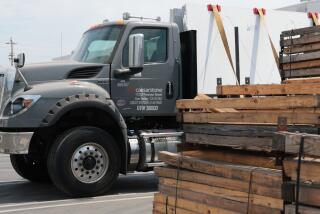Waterford Stems Red Ink, but at Expense of Irish Workers : Glass: Crystal maker recovers by cutting home work force, marketing cheaper foreign product.
WATERFORD, Ireland — To most people, the chunk of crystal sitting on the table looks like a big ice cube, but Fred Curtis envisions a winged horse. The hard part, he says, will be sculpting the fragile front legs without breaking them.
“I’ll wait till the place is empty at night and work here in the silence,” Curtis tells a visitor to the Waterford Crystal plant. “This will be difficult.”
In another room, engraver Tom Hayes balks at putting a price on a fancy crystal globe.
“I’m not being glib, but something’s worth what people will pay for it,” Hayes says. “We’re trying to create an art.”
Curtis and Hayes are two of the Irish master craftsmen who make Waterford crystal a household name. They are also two of the fortunate ones--economic realities have left hundreds of other Irish craftsmen out of work as the company adjusts to a more competitive global marketplace, in part by marketing cheaper crystal from abroad.
Waterford Wedgwood PLC ran into trouble when the recession left it staggering under yearly losses of around 20 million Irish pounds, the equivalent of $30 million. Investors led by Irish tycoon Tony O’Reilly and Wall Street powerhouse Morgan Stanley & Co. bought a 29% stake in 1990 and put the company on a new course.
Within three years, they had erased the losses and earned 9 million Irish pounds in 1993. That brought the company’s stock price back from 14 pence two years ago to nearly four times as much these days.
But success has come painfully. Hundreds of Irish workers lost their jobs as Waterford cut costs and started buying cheaper crystal from sources in Germany and Slovenia--and gained a bigger share of the vital U.S. market under an also-ran brand name, Marquis by Waterford.
The company’s saving from manufacturing overseas is substantial. Every time Waterford sells a $30 wine glass under the Marquis name, it makes more money than it does by selling a $50 Waterford wine glass.
At Waterford Wedgwood’s recent annual meeting in Dublin, shareholders were relieved to be back in the black. But amid the expected gripes about big stock options for directors and the predictable clamoring for a dividend--the company’s hasn’t paid one since 1988--were calls to bring jobs back to Ireland.
Unemployment, officially listed at 15.2% but widely believed to be nearer 20%, is Ireland’s top problem and an emotional issue--even to Irish investors who profit when jobs are exported.
“I propose we take our money out of Germany, that doesn’t need it, and put it back in Ireland, with our unemployment,” said a shareholder who did not identify herself.
Other Waterford Wedgwood shareholders are concerned that selling cheaper crystal could hurt the company.
“My concern is that the integrity of the brand is in grave danger if we reduce the number of craft workers,” said Neal Duggan, a Dublin accountant. “We’re in danger of eroding the brand.”
O’Reilly, now chairman of Waterford Wedgwood, said Waterford’s share of the key U.S. crystal market had advanced from 27% in 1990, the year before the European imports were added to the line, to 34% last year.
“Only a fool could not understand those numbers--this company was headed for liquidation,” said O’Reilly, who also runs Pittsburgh-based H.J. Heinz Co.
Waterford’s chief executive, Paddy Galvin, agreed in an interview that the Irish shareholders “make comments with their hearts, not with their heads.”
Had Waterford not cut its work force to 1,500 from 3,000 over the past few years, slashed pay and brought in cheaper foreign crystal, the plant would have closed, he said.
The changes have been bitter for Waterford’s workers. But union leaders at the crystal plant put off repeated requests from the Associated Press to discuss the matter in detail.
Many ordinary Irish cringe when asked about Waterford’s bringing in cheaper crystal from Eastern Europe.
“It’s like having a Rolls-Royce made in Japan,” said Dublin native Anthony Campion.
“There is a risk they dilute the brand name,” agreed Allison Stewart, a marketing consultant in London. “The way they can prevent that risk is to throw money at the Marquis range and brand it differently.”
Galvin said Waterford makes sure there is no confusion, insisting, for example, that retailers display the brands on different shelves.
“We’re paranoid about quality,” he said.
The company contends that high-quality products, hand-made by such craftsmen as Curtis and Hayes, will keep the Waterford name in good repute.
“The prestigious pieces are creating a halo effect, which is counteracting any negative that might be perceived as you go downscale,” Galvin said.
More to Read
Inside the business of entertainment
The Wide Shot brings you news, analysis and insights on everything from streaming wars to production — and what it all means for the future.
You may occasionally receive promotional content from the Los Angeles Times.









